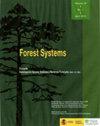人工神经网络与回归建模技术预测东方云杉混交林优势高度的比较
IF 0.7
4区 农林科学
Q3 FORESTRY
引用次数: 0
摘要
研究目的:介绍了基于拟合统计量和期望特征的人工神经网络模型和回归建模技术对优势身高预测的比较评价。研究区域:本研究的数据来自土耳其东北部均匀老化和混合的东方云杉和苏格兰松(Pinus sylvestris L.)林中的东方云杉(Picea orientalis L.)砍伐的树木。材料和方法:从一个混交林中的东方云杉树上共获得873个高龄对。比较了非线性混合效应模型(NLME)、自回归模型(ARM)、虚拟变量法(DVM)和人工神经网络(Ann)来预测优势身高增长。主要结果:最佳预测模型是具有单个随机参数的NLME(均方根误差,RMSE:0.68m)。结果显示,在大多数情况下,NLME的表现优于ARM(均方根误差:1.09 m)、DVM与ARM的结合(均方根值:1.09米)和Ann(均方根系数:1.11至2.40米)。通过随机参数考虑观测值之间的变化显著改善了优势高度的预测,而通过自回归相关参数考虑相关误差项略微增强了预测。与具有ARM的NLME、ARM和DVM相比,Ann通常表现不佳。研究重点:所有回归技术都满足了理想的特征,如S型模式、多态性、多重渐近线、基本年龄不变性和拐点。然而,人工神经网络不能复制这些特征中的大部分,不包括S型模式。因此,人工神经网络似乎不足以保证关于显性身高增长的生物学增长假设。本文章由计算机程序翻译,如有差异,请以英文原文为准。
A comparison of artificial neural networks and regression modeling techniques for predicting dominant heights of Oriental spruce in a mixed stand
Aim of study: This paper introduces comparative evaluations of artificial neural network models and regression modeling techniques based on some fitting statistics and desirable characteristics for predicting dominant height.
Area of study: The data of this study were obtained from Oriental spruce (Picea orientalis L.) felled trees in even-aged and mixed Oriental spruce and Scotch pine (Pinus sylvestris L.) stands in the northeast of Türkiye.
Material and methods: A total of 873 height-age pairs were obtained from Oriental spruce trees in a mixed forest stand. Nonlinear mixed-effects models (NLMEs), autoregressive models (ARM), dummy variable method (DVM), and artificial neural networks (ANNs) were compared to predict dominant height growth.
Main results: The best predictive model was NLME with a single random parameter (root mean square error, RMSE: 0.68 m). The results showed that NLMEs outperformed ARM (RMSE: 1.09 m), DVM in conjunction with ARM (RMSE: 1.09 m), and ANNs (RMSE: from 1.11 to 2.40 m) in the majority of the cases. Whereas considering variations among observations by random parameter(s) significantly improved predictions of dominant height, considering correlated error terms by autoregressive correlation parameter(s) enhanced slightly the predictions. ANNs generally underperformed compared to NLMEs, ARM, and DVM with ARM.
Research highlights: All regression techniques fulfilled the desirable characteristics such as sigmoidal pattern, polymorphism, multiple asymptotes, base-age invariance, and inflection point. However, ANNs could not replicate most of these features, excluding the sigmoidal pattern. Accordingly, ANNs seem insufficient to assure biological growth assumptions regarding dominant height growth.
求助全文
通过发布文献求助,成功后即可免费获取论文全文。
去求助
来源期刊

Forest Systems
FORESTRY-
CiteScore
1.40
自引率
14.30%
发文量
30
审稿时长
6-12 weeks
期刊介绍:
Forest Systems is an international peer-reviewed journal. The main aim of Forest Systems is to integrate multidisciplinary research with forest management in complex systems with different social and ecological background
 求助内容:
求助内容: 应助结果提醒方式:
应助结果提醒方式:


